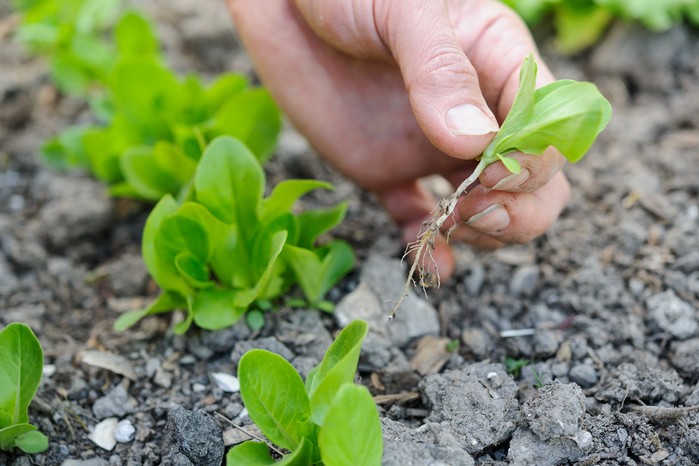Growing your own lettuce at home is one of the easiest and most rewarding gardening projects you can start. Whether you live in a house with a garden or an apartment with just a sunny balcony, you can enjoy crisp, fresh lettuce all year round. In this guide, you’ll discover the best way to how to plant lettuce seeds at home, from choosing the right variety to harvesting your first leafy greens.This step-by-step guide will help you create a thriving mini lettuce garden — even if you’re a beginner!🥬 Why Grow Lettuce at Home?Before we dive into the best way to how to plant lettuce seeds at home, let’s look at why this leafy green is perfect for home gardeners:Fast-growing: Lettuce can be ready to harvest in as little as 30 days.Space-friendly: It grows well in pots, containers, and garden beds.Low-maintenance: Requires minimal care and grows quickly.Continuous harvest: You can pick outer leaves and let the plant keep growing.Fresh and healthy: Homegrown lettuce is pesticide-free and rich in nutrients like vitamin A, C, and K.No matter where you live — in the United States, United Kingdom, or Canada — lettuce can be grown easily with a bit of attention to light, water, and soil.🌱 Step 1: Choose the Right Lettuce VarietyTo learn the best way to how to plant lettuce seeds at home, start by selecting a variety that suits your climate and taste preferences. There are several types of lettuce, each with its own unique flavor and texture:🥗 Loose-leaf lettuce: Easy to grow, ideal for beginners (e.g., Green Salad Bowl, Oakleaf).🧊 Crisphead (Iceberg) lettuce: Crunchy texture, needs cooler conditions.🥬 Romaine (Cos) lettuce: Tall leaves with a firm texture, great for Caesar salads.🌿 Butterhead lettuce: Soft and sweet (e.g., Boston, Bibb).If you’re planting indoors or in containers, loose-leaf and butterhead types tend to perform best.🌿 Step 2: Gather Your SuppliesTo follow the best way to how to plant lettuce seeds at home, make sure you have:Lettuce seeds (your chosen variety)Potting soil (rich, loose, and well-draining)Containers or pots (at least 6 inches deep with drainage holes)Spray bottle or watering canSunny spot or grow lightsLettuce prefers cool weather and partial sunlight (about 4–6 hours a day), making it ideal for spring and fall planting.🌾 Step 3: Prepare the SoilHealthy soil is key to a thriving lettuce garden. Use a high-quality potting mix or garden soil enriched with compost. Lettuce grows best in slightly acidic to neutral soil (pH 6.0–7.0).Loosen the soil and remove debris or stones.Mix in organic compost to improve nutrient content.Make sure the soil stays light and airy to allow proper root growth.🌼 Step 4: Sow the Lettuce SeedsNow comes the exciting part — planting your seeds!Here’s the best way to how to plant lettuce seeds at home:Fill your container or garden bed with prepared soil.Sprinkle the lettuce seeds evenly over the surface.Cover them lightly with a thin layer of soil (about ¼ inch deep) — lettuce seeds need some light to germinate.Mist gently with water using a spray bottle to avoid displacing the seeds.Within 5 to 10 days, you should see tiny green sprouts appearing!💧 Step 5: Watering and CareLettuce loves consistent moisture, but it doesn’t like soggy soil.Water lightly every day or as needed to keep the soil damp.Avoid overwatering to prevent root rot.Mulch around your plants to help retain moisture and keep the soil cool.If growing indoors, rotate your containers occasionally so that each side of the plant receives equal sunlight.☀️ Step 6: Provide the Right Light and TemperatureLettuce thrives in cool conditions (60–70°F / 15–21°C). Too much heat can cause it to bolt (flower prematurely) and turn bitter.For indoor gardening:Place the container near a bright window or under grow lights for 12–14 hours a day.Keep the temperature consistent and avoid placing near heat sources.For outdoor gardening:Choose a spot with morning sun and afternoon shade, especially in warmer climates.🌿 Step 7: Thin and Transplant SeedlingsOnce your seedlings are about 2 inches tall, thin them out so that each plant has enough space to grow.For loose-leaf varieties: keep about 4–6 inches between plants.For larger types like Romaine or Butterhead: space 8–10 inches apart.You can replant the extra seedlings in another pot or garden spot.🪴 Step 8: Fertilize (Optional)Lettuce doesn’t require heavy feeding, but adding a mild organic fertilizer every 2–3 weeks helps maintain steady growth.Use a balanced liquid fertilizer (like 10-10-10) diluted to half strength to avoid burning the tender leaves.🥗 Step 9: Harvesting Your LettuceThe best part of learning the best way to how to plant lettuce seeds at home is enjoying your harvest!You can harvest lettuce in two ways:Cut-and-come-again method: Snip outer leaves when they’re about 4–6 inches long, and let the inner ones continue growing.Full harvest: Cut the entire plant at the base once it reaches maturity (usually 45–60 days).Regular harvesting encourages new growth and keeps your plants producing longer.🌸 Practical Tips for SuccessSow seeds every 2–3 weeks for a continuous supply of fresh lettuce.Keep pests away: Watch for aphids and slugs — use neem oil or natural remedies.Don’t overcrowd: Good airflow helps prevent fungal diseases.Store harvested lettuce: Rinse leaves and store them in the fridge wrapped in a damp paper towel.🌞 Benefits of Homegrown LettuceGrowing lettuce at home isn’t just fun — it’s a healthy and sustainable habit!Fresher, more flavorful leavesZero pesticides or chemicalsCost-effective compared to store-bought greensEncourages mindful eating and gardening satisfactionWith this best way to how to plant lettuce seeds at home, you’ll always have crisp, garden-fresh lettuce ready for salads, sandwiches, and wraps.🌿 Conclusion: Start Planting Today!Now that you know the best way to how to plant lettuce seeds at home, it’s time to grab your seeds, prepare your soil, and get growing! This easy project brings delicious rewards and can fit into any lifestyle — from small-space apartment gardening to backyard plots.Lettuce is forgiving, fast-growing, and endlessly useful in your kitchen. So don’t wait — start your mini lettuce garden today and enjoy the taste of fresh, homegrown greens straight from your own hands!

